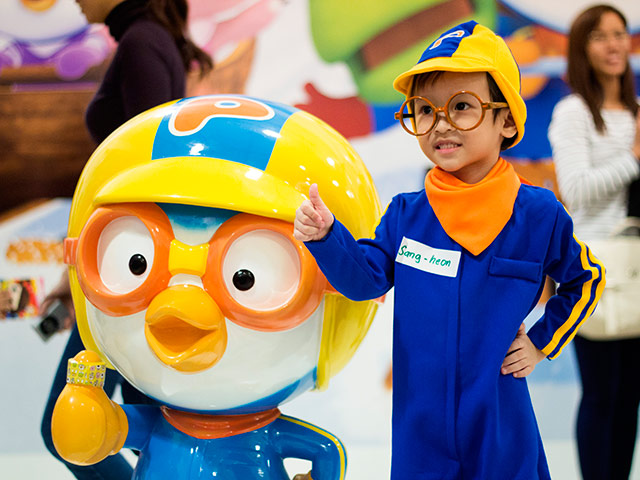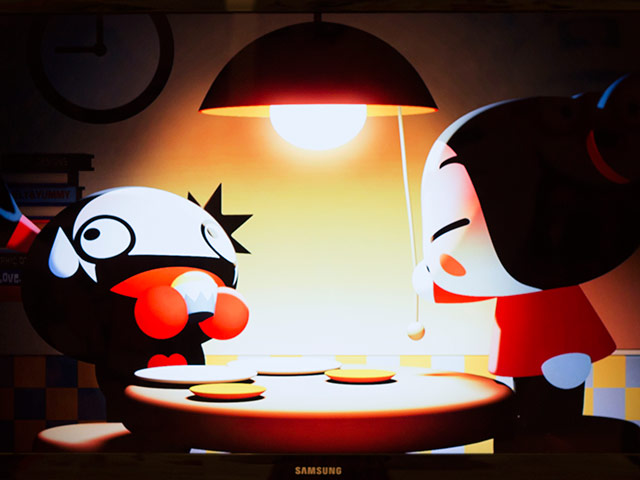Filtered By: Lifestyle
Lifestyle
K-Animation: The latest Hallyuwave comes to Manila
Text and photos by ANALYN PEREZ, GMA News
We’re all familiar with Western and Japanese animation by now, but there is a new kind of Hallyuwave sweeping the globe: Korean animation.
K-Animation, as they call it, relies on its lovable characters and universal storylines unlike K-Pop, which depends on the popularity of celebrities, and K-Dramas, which require a certain level of cultural understanding.
The Korean Cultural Center’s exhibit opening day on Feb. 7 was a chance for kids to be with their favorite K-Animation characters and for parents to have quality time with their kids.

President of Children: A child dresses up as his favorite character Pororo.
From robots to the Little Penguin
K-Animation dates back to 1967 when Korean animation studios were subcontracted for various animation projects. In the 1970s, the trend were battle mechas and robots and Taekwon V became a home-grown favorite of Korean kids back then.
Even though it has gained popularity, K-Animation did not gain much traction because of several cultural taboos. Koreans at the time believed animation could destroy children’s minds and make them unproductive in the future.
That changed when “Pororo The Little Penguin” was aired at the dawn of the 21st century. The beloved blue penguin was dubbed the “President of Children” in Korea and gained acclaim even abroad. The animation was received well because some of the symbolisms of the show is tied to tradition such as the white snowy backdrop of the Porong Porong Forest, which in Korean tradition symbolizes purity and innocence.

We’ve all been there: Pucca is a story of a 10-year old girl who falls in love with 12-year old Garu. The tale of Pucca’s unrequited love is a story everyone can relate to, whether young or old.
Universal Themes
Unrequited love to coming of age are just some of the many themes that audiences of all ages can relate to. Some may have unique themes like Cloud Bread and some veer away from the usual traditional image of girls. In animated series like "Pucca" and "Hello Jadoo", main female characters take the initiative, breaking away from the usual princess image that dominates mass media.
Meanwhile, some K-Animations are not just for kids. Art film “Green Days: Dinosaur and I”, an adolescent cartoon about coming of age, has received great reviews for its classic production and universal storyline about growing up.

Annyeong Haseyo Jadoo: Kids and kids at heart can appreciate K-Animation merchandises on display at the KCC hall.
Meeting the characters
At the exhibit's opening day, children were able to play along with their favorite characters from Tayo the Little Bus, Cloud Bread, Canimals, Pororo, and Pucca.
Parents enjoyed quality time with their kids through various activities such as face painting, building pop-up models and playing board games while not-so-young visitors reunited with their favorite childhood character Pucca.
Parents enjoyed quality time with their kids through various activities such as face painting, building pop-up models and playing board games while not-so-young visitors reunited with their favorite childhood character Pucca.
In his opening remarks, KCC Director Hwang Seong Un indicated that the advancement in animation also reflects the country’s progress in technology.
From a creative standpoint, a single animated series requires many hours of manpower from conception to creation. Producing one that is good enough to export has heavy technological and funding requirements.
The South Korean government has invested in K-Animation to ensure top-quality cartoons are produced each year. Like in KPop and KDramas, the gamble on K-Animations has paid off in the recent years.
The estimated brand value of K-Animation is about 850 billion Korean Won ($790M USD) and 90 percent of Pucca’s income comes from outside Korea. Not only is K-Animation beneficial for the country’s trade growth but has officially become part of the Hallyuwave craze all over the world. — JDS, GMA News
“The Delight of Korean Animation Character World” exhibit will run from Feb. 7 to May 10, 2014 at the Korean Cultural Center of the Philippines in Bonifacio Global City, Taguig City.
More Videos
Most Popular



